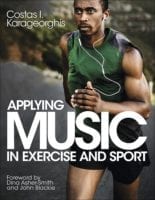The workout playlist backed by science
 When a Lycra-clad Olivia Newton-John sang Let’s Get Physical, she was tapping into a well-established trend: music and fitness go together like dodgy legwarmers and 1980s aerobics videos. Think about it: when was the last time you went to a gym without upbeat chart-toppers piped throughout the building, or set out for a run without your trusty headphones firmly in place?
When a Lycra-clad Olivia Newton-John sang Let’s Get Physical, she was tapping into a well-established trend: music and fitness go together like dodgy legwarmers and 1980s aerobics videos. Think about it: when was the last time you went to a gym without upbeat chart-toppers piped throughout the building, or set out for a run without your trusty headphones firmly in place?
Something about pounding beats and swelling tempos gets us pumped, and with more than 25 million workout playlists created on music streaming service Spotify, there’s got to be some science behind it. ‘The power of music is real,’ says Dr Costas Karageorghis, expert in sports psychology at Brunel University, London. ‘It really does enhance our workouts.’
Dr Karageorghis has researched the psychological effects of music on exercise for more than 20 years. With the likes of Nike, Sony, David Lloyd health clubs and even Olympic athletes benefiting from his expertise, plus collaborations with Ministry Of Sound under his belt, it’s fair to say he knows the score. ‘The benefits are of a small to moderate nature, but they are certainly there,’ he says. ‘And for some, music can make a critical difference.’ So how does it work?
Track trickery
‘The most consistent effect of music is that it reduces our sense of how hard we think we’re working,’ says Dr Karageorghis. ‘It makes exercise seem a little bit easier, and well-chosen music reduces your perceived exertion by around 12 per cent.’ And ‘well-chosen’ means any genre of music you like that’s relevant to the intensity of activity you’re doing.
Neurophysiological research shows that music blocks some of the signals from our muscles to our central nervous system – so some of the messages telling us we’re fatigued never enter our awareness. Even if you don’t like the music playing, it can still reduce your perception of effort by around eight per cent, which is good news for anyone who’s been at a spin class where the instructor has a less-than-cool taste in banging Euro-pop.
Go with the flow
Ever realised you’ve matched your walking pace to the beat in your headphones? This is called entrainment, and is a predisposition that sees our bodies synchronising to an external rhythm. ‘There’s a tendency for the heart rate, respiration rate, breathing rate and brainwaves to lock into musical rhythm,’ says Dr Karageorghis. ‘When we move in time with music, that’s a specific type of entrainment – auditory-motor synchronisation.’
Everything from cycling to squatting in time with music demonstrates this synchronisation, which reduces the frequency of certain brainwaves. ‘This is called entering flow, where there’s less conscious processing, lower anxiety and greater enjoyment.’ In short, we can happily exercise away on autopilot if we have the right soundtrack.
Change your tune
Sometimes nothing beats blasting a feel-good ballad for a quick mood boost. It’s been discovered that even at high intensities of exercise, music can have a positive effect on our pleasure centres. ‘Music can’t influence what we feel, but it can influence how we feel,’ says Dr Karageorghis. ‘The good vibes we get from music can colour our interpretations of fatigue, making it a more positive experience.’
And if our experience of exercise is a brighter one, we’re more likely to continue working out. ‘This is why even if you’re sweaty, breathless and coming up towards exhaustion, music can keep you going.’
Sing praises
There’s a reason you don’t see a lot of instrumentals in the charts. ‘Lyrics can provide strong messages to the brain that influence behaviour,’ explains Dr Karageorghis. ‘Whether that’s Ain’t No Mountain High Enough or Jump To The Beat, we look for messages to internalise.’
This is called syntactic processing, and can involve individuals picturing themselves within the context of the song. ‘Many men cite Eye Of The Tiger by Survivor as a favourite workout track, as it’s associated with Rocky, and has a motivational lyric. They see themselves as Rocky Balboa, raising their arms aloft, shouting “Yo Adrian, I did it!”.’
Science-backed workout tunes
The pace of songs – measured in beats per minute (bpm) – can be motivating, so match your activity to the right track. Here’s a science- approved selection to try.
WARMING UP
‘You don’t want particularly energising tracks, you want those that bridge the gap from a sedate state to an active state.’ Such as:
Roar – Katy Perry: 90bpm
Girl on Fire – Alicia Keys: 93bpm
Work From Home – Fifth Harmony, featuring Ty Dolla $ign: 105bpm
RUNNING
‘These are some of the tracks from a scientifically-selected playlist I prepared for running.’
Low intensity: Run Baby Run – Sheryl Crow: 124bpm
Moderate intensity: Run The World (Girls) – Beyoncé: 127bpm
High intensity: Runnin’(Lose It All) – Naughty Boy featuring Beyoncé and Arrow Benjamin: 140bpm or Born to Run – Bruce Springsteen: 148bpm
INDOOR CYCLING
‘This is a marriage made in heaven – cycling and music sync perfectly.’
Low intensity: Good Life – Inner City: 121bpm or Can’t Stop The Feeling – Justin Timberlake: 113bpm
Moderate intensity: Work Hard Play Hard – Tiësto: 128bpm, Tour De France – Kraftwerk: 134bpm, or Boom Boom Pow – Black Eyed Peas: 130bpm
High intensity: Rockafeller Skank – Fatboy Slim: 153bpm or Sex on Fire – Kings of Leon: 152bpm.
WEIGHT TRAINING
‘In terms of weight training, the research I’ve done suggests people who are regular gym goers particularly enjoy music from the hard rock and rap idioms.’
Low intensity: Hip Hop Hooray – Naughty By Nature: 100bpm or Mama Said Knock You Out – LL Cool J: 102bpm
Moderate intensity: Fight The Power – Public Enemy: 106bpm
High intensity: Highway To Hell – AC/DC: 116bpm or For Whom The Bell Tolls – Metallica: 118bpm
WHEN YOU’RE FLAGGING
Emotionally: Fancy – Iggy Azalea: 93bpm
Physically: All About That Bass – Meghan Trainor: 134bpm, Pushing On – Oliver $ and Jimi Jules: 125bpm, or Break Free – Ariana Grande featuring Zedd: 130bpm
COOLING DOWN
‘Post-exercise you want a gradual reduction in tempo, and immersive qualities in the music help, too.’ Recuperate with these:
Orinoco Flow – Enya
Lovely Day – Bill Withers
Albatross – Fleetwood Mac
 Find out more in Applying Music In Exercise And Sport by Dr Costas Karageorghis (Human Kinetics, £33.99)
Find out more in Applying Music In Exercise And Sport by Dr Costas Karageorghis (Human Kinetics, £33.99)











